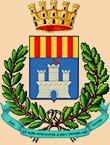Museo dell'intreccio mediterraneo di Castelsardo
Main site sections
Castelgenovese: The city of the Doria family
The history of Castelsardo originates under the medieval name of Castelgenovese, the fortress belonging to the Ligurian family, the Doria. Its story is linked to a myth belied by historical fact: its founding, for centuries dated at 1102, because of an erroneous interpretation of medieval data by the historian and humanist Giovanni Francesco Fara from Sassari (1543-1591). The exact year is difficult to establish because a foundation charter of the fortress does not exist, it was first mentioned in 1272 in a letter sent by Carlo D’Angiò, King of Sicily to the municipality of Genoa asking that justice be rendered to Guglielmo di Saint-Gilles, a citizen of Palermo, who had been imprisoned in the fortress. The earliest documentation of the Doria family's dominion dates to February 1282, when Brancaleone sold Castelgenovese, Casteldoria and the former district (curatoria) of Anglona to Corrado Malaspina, buying both castles back later in the same year for the sum of 9300 lire.
The medieval archaeological findings also date back to the thirteenth century, key period for the founding of other cities such as Alghero, Monteleone, and numerous castles belonging to the Doria family, the Malaspina family and other of the peninsula's nobility.
Doria
The affirmation of the Doria in Sardinia was progressive. Initially merchants, they then financed the Giudicati di Torres and Arborea, became influential landowners and consequently territorial lords. Their political skill led them to associate with the Giudici (governors) of the Giudicati in order to influence them and establish ties with them. The first reference to their history on the Island dates to somewhere between 1154 and 1164 when Ansaldo and Simone Doria, merchants of Genoa, landed in Sardinia.
The turning point for the affirmation of the Doria's rule came in 1259 when the Giudicessa Adelasia Di Torres died without heirs. The noble families (Doria, Pisani, Genovesi, Gherardesca, Malspina and Donoratico) and the institutions (the Giudici of Arborea and Gallura and the municipalities of Sassari, Pisa and Genoa) fought for the conquest of the territories of the Giudicato and to defend their acquired privileges. Hence the need to build castles for defense purposes and to establish civil and political power. Many strategic places came under the administration of the Turritan Doria: Monteleone, Alghero, Casteldoria, Castelgenovese and many more satellite places.
Castelgenovese
The founding of the castle and the fortified village guaranteed Castelgenovese a strategic role in the Doria family's dominion, which had had, since 1287, complete independence from Genoa. During 1200 the castle became an important commercial point for sea traffic from the Gulf of Asinara to Liguria and Corsica. Between the thirteenth and fourteenth centuries, Brancaleone I Doria was the leading exponent of the family. He safeguarded its rights to Sardinian possessions during the Catalan-Aragonese conquest and gained the title of “dominus”, Lord of Castelgenovese. Another important figure was Brancaleone III Doria who in circa 1366 married Eleonora d'Arborea, taking, unlike his predecessors, a pro-Catalan position.
The village remained his primary residence until his death in 1408. Nicolò Doria, the illegitimate son of Brancaleone Doria III was the last exponent of politics that were adverse to the Aragonese presence in Sardinia. Under Nicolò Castelgenovese became the last bastion for sea traffic to the Strait of Bonifacio. In circa 1435, he completed the customs statute that had been issued in about 1334 by Galeazzo Doria in order to promote the role that Castelgenovese played in trading and taxation and to obstacle Iberian advances.


